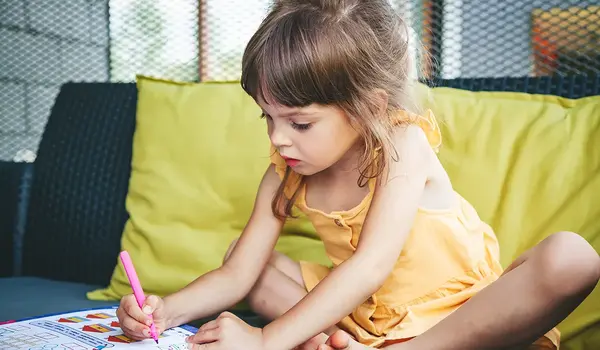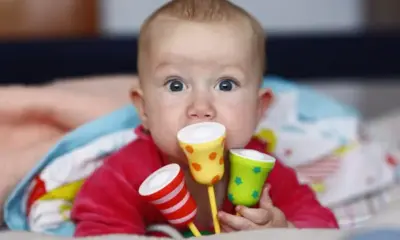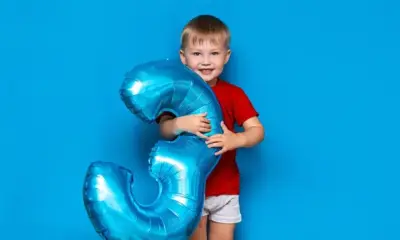Preschooler Development
11 Fun Activities to Boost Your Toddler’s Development

One of the most important activities for your child is play. Not only is it enjoyable, but it also provides toddlers with opportunities to explore the world around them and develop vital skills. Caregivers can enhance this learning experience by organizing fun, interactive, and educational activities at home.
Need some ideas? Here’s a list of 11 developmental activities for toddlers. These activities foster physical, cognitive, and emotional growth, while also encouraging parent-child bonding, strengthening your relationship.
The best part? Most of these activities use common household items like painter’s tape, cotton balls, drawing materials, and paper. Your toddler will have a blast while boosting their development!
Explore Textures
Toddlers are sensory learners, and they engage with the world through touch, smell, and taste. Use a dark marker to trace letters and numbers on poster board, and encourage your toddler to decorate the letters with textured materials like sandpaper, cotton balls, and pipe cleaners (avoid small items that could be choking hazards).
Feeling the letters helps toddlers understand how they’re formed, and for those learning to write, it’s a great way to practice the shapes before using a pencil. As your child runs their fingers over the letters, say the letter names and sounds aloud. You can even extend the activity by creating a name poster, helping your child recognize the letters in their name on signs, billboards, and more.
Measure Up
This activity teaches toddlers about measurement using everyday objects. Instead of just using a ruler, try measuring with different things. For instance, you can measure how many “leaves tall” your child is by lying down on the grass, or determine how many “Legos tall” the couch is.
For more fun, count how many of your child’s books it takes to cover the bed. As you do these activities, your child will practice counting and measuring in creative ways.
Label Your House
Pick a few items around the house, like the refrigerator, windows, and chairs, and label them with simple words using large text. Use painter’s tape, which is easy to remove. Rotate the labeled objects every few months for variety.
If your child is old enough to recognize letters, ask them to identify the letter “L” and place the label on the lamp. If not, point out the letter and its sound, such as, “Lamp starts with ‘L’. Can you stick this on the lamp?” Over time, your child will be able to recognize the labels independently.
Introduce Organization
Get your child involved in organizing by helping them put things away in their proper places. Although it might slow down tasks, children as young as 3 can help with simple chores. This fosters a sense of responsibility and self-esteem.
Combine this with the “Label Your House” activity by assigning specific places for toys, clothes, and dishes. As you put things away, turn it into a game by asking, “Where do your toys go?” or by placing objects in the wrong spots for your toddler to fix.
Arrange a Scavenger Hunt
Toddlers are natural explorers and love to investigate. Plan a scavenger hunt by asking your child to find objects of a particular color (like purple) or shape (like a circle). For extra help, provide three objects and ask which one is a circle or red.
Expand on the “Label Your House” activity by having your child find items with specific labels or look for a particular letter or number on the bookshelf. You can also pretend to search for items, like asking your toddler to find the orange juice carton.
Take on the Town
Help your child familiarize themselves with your town by pointing out important places like the supermarket, fire station, or gas station. Discuss what each place is and who works there.
Draw pictures of these places and put them on index cards with details about each location. When you’re out, refer to these cards to reinforce the information. For example, ask, “Do you buy clothes at the dry cleaner, or do you pick up cleaned clothes?”
Sing Vocabulary Words
Singing is a fun way to expand your child’s vocabulary. Create silly songs about rhyming words, counting to 10, or singing classic tunes like the “Alphabet Song” or “The Itsy Bitsy Spider.” Children learn an average of nine new words a day during their pre-reader years, and songs help reinforce language development.
Sing together in the car, during playtime, or at bath time. If your child attends daycare or preschool, ask for the songs they enjoy, and reinforce them at home.
Number Your Mornings
Create a calendar grid on a poster board and attach Velcro to the back of numbered cards (1-31) and days of the week. Place the calendar at your child’s eye level and help them add the correct number card to the calendar each day.
Encourage your child to identify the next number and its corresponding day of the week. Singing a “Days of the Week” song can further help reinforce the routine and provide comfort to your child.
Pin Up Pictures
Help your child associate words with faces by placing pictures of family and friends on a bulletin board, labeling them with names like “Aunt,” “Uncle,” or “Cousin.” As your child becomes familiar with each person, remove the sticky notes with their names.
You can also extend this activity by reading books about family members and asking your child to identify each one. Over time, you could create a family tree with pictures and names, making it a fun, evolving artwork in your home.
Set Up a Weather Windows Wall
Turn your child into a junior meteorologist by creating a weather window. Let them draw the weather for the day on a piece of paper and frame it with strips of brown construction paper. Add a word like “sunny,” “rainy,” or “snowy” to describe the weather.
Hang the “windows” in a weather corner and update them each month to track changes in weather patterns.
Encourage Pretend Play
Pretend play is a great way for toddlers to learn about the world. By emulating adults like doctors, nurses, or firefighters, children develop their social skills and creativity. Give your child simple clothes to dress up in, such as hats or an apron, and encourage them to lead the play.
Pretend play is also a great way to prepare your child for real-life situations, like using a toy doctor’s kit to prepare for a pediatrician visit.
By integrating these fun and educational activities into your child’s routine, you’ll help them grow and develop in all the best ways!






